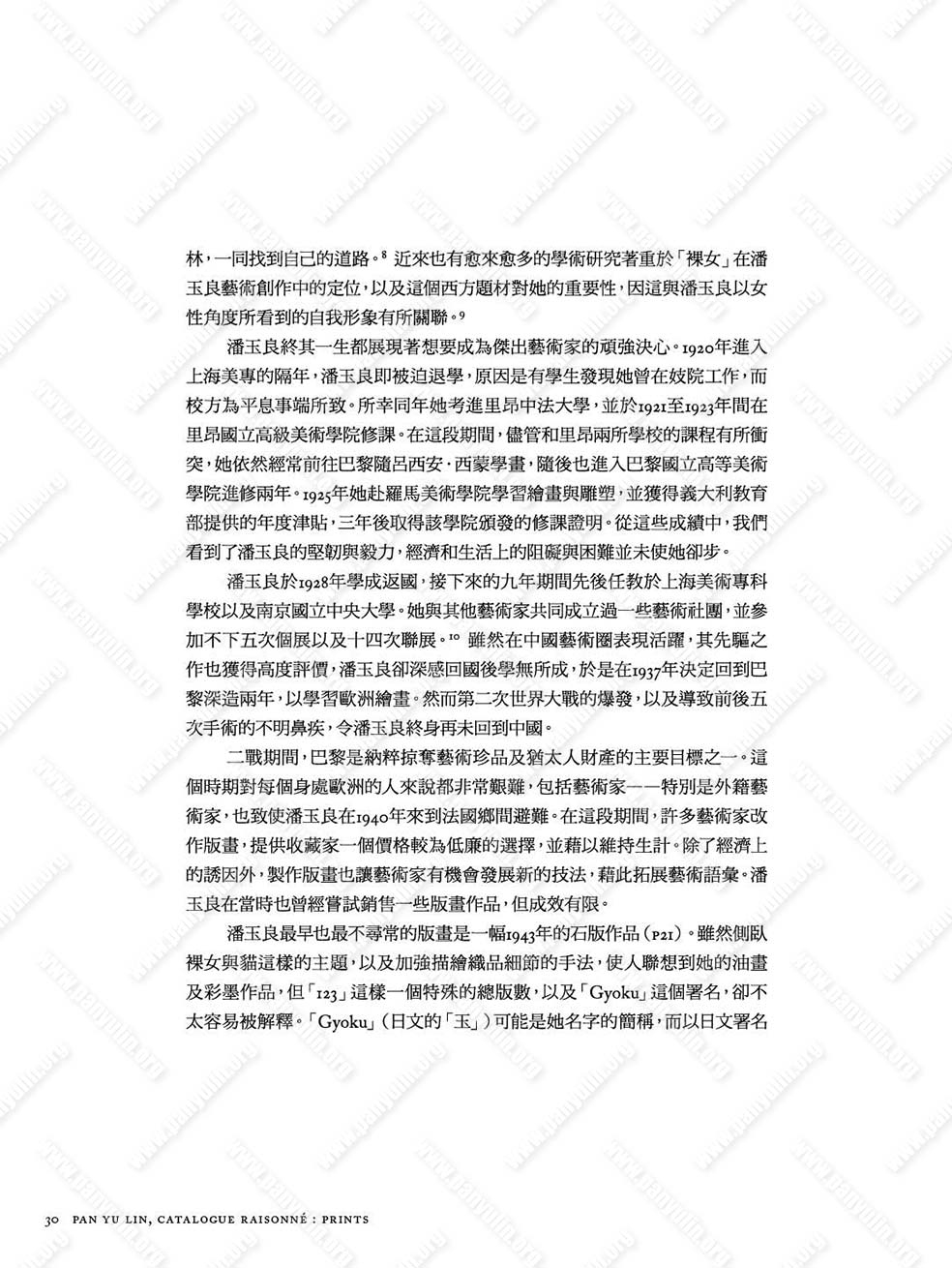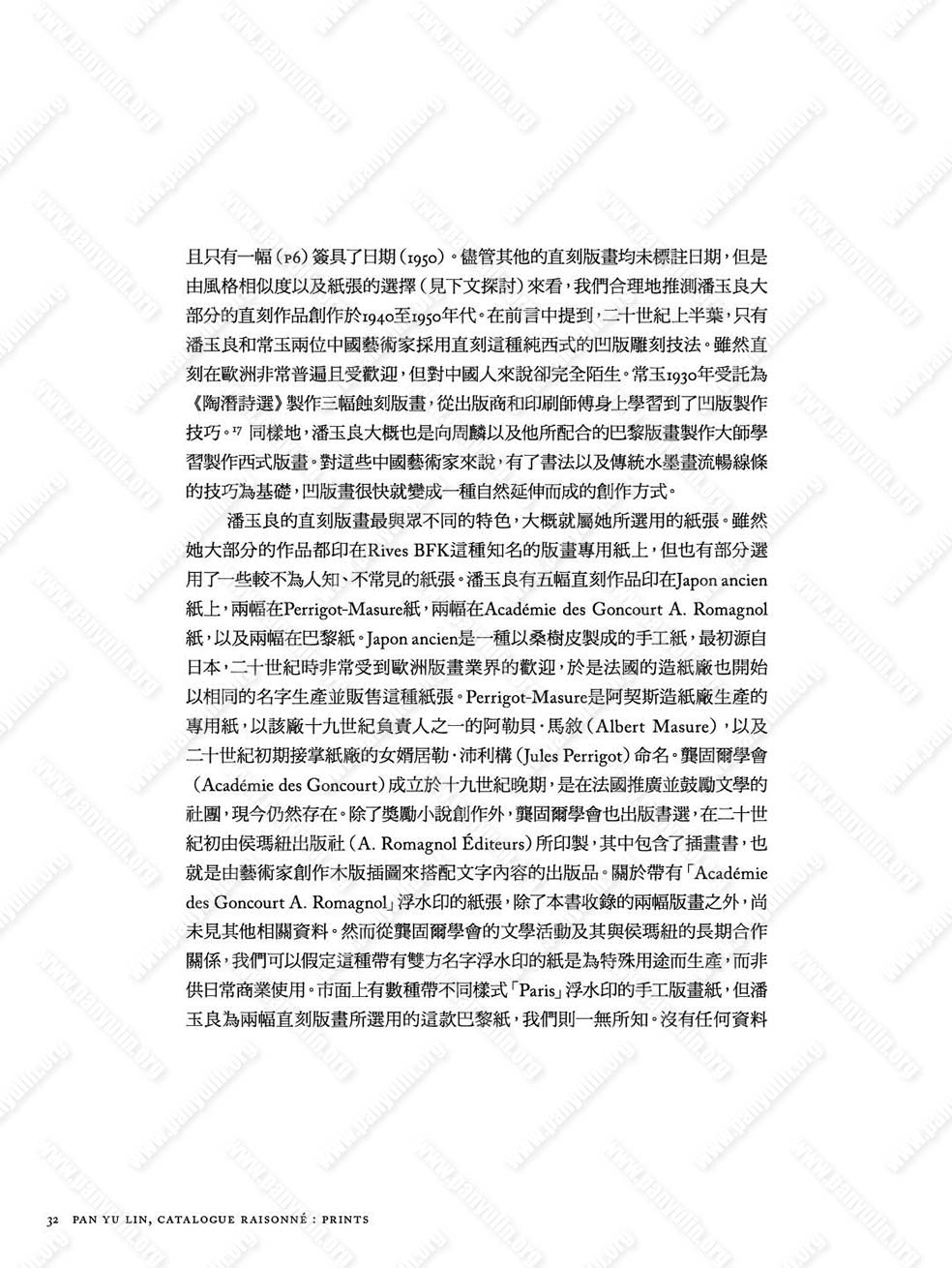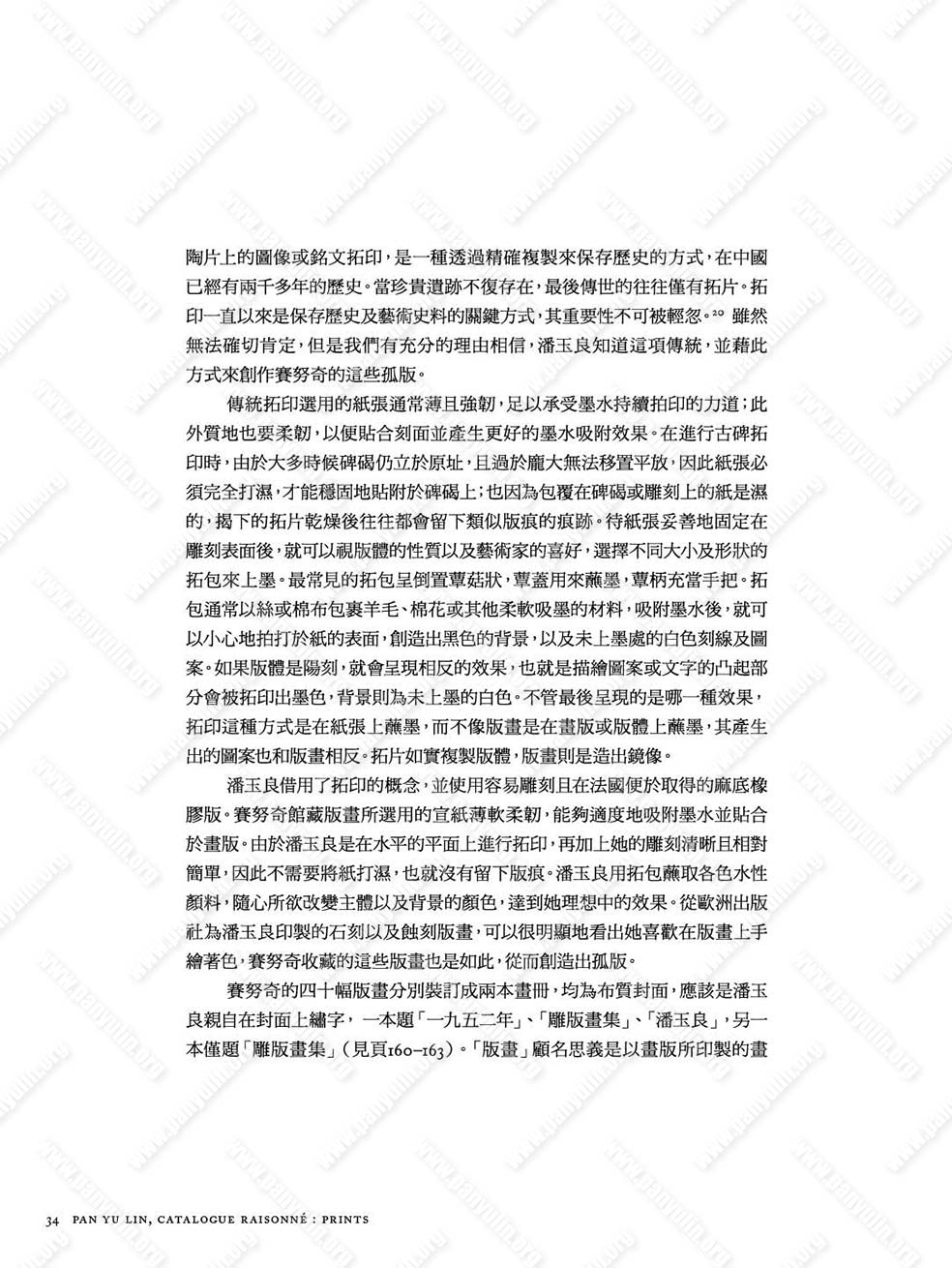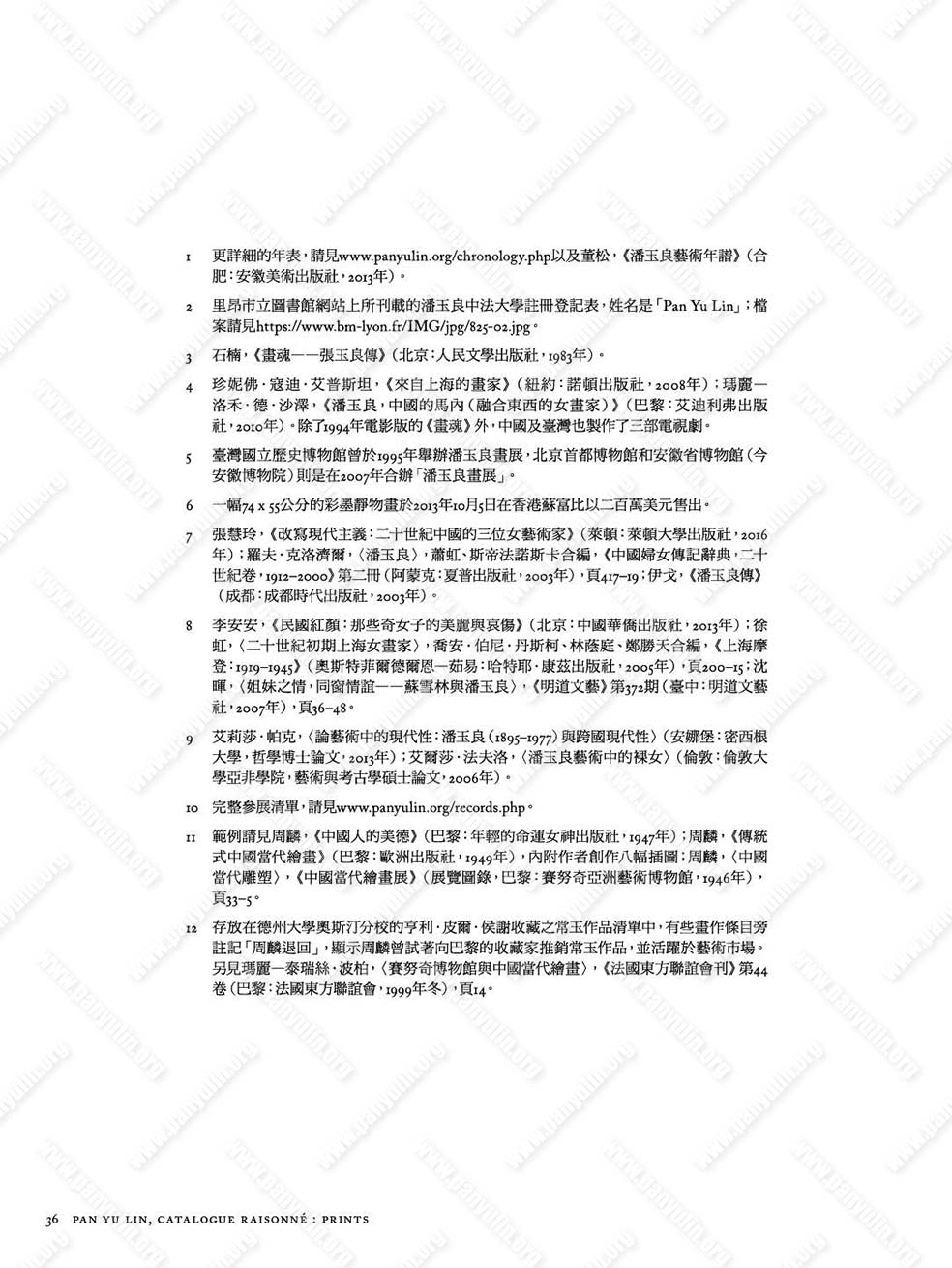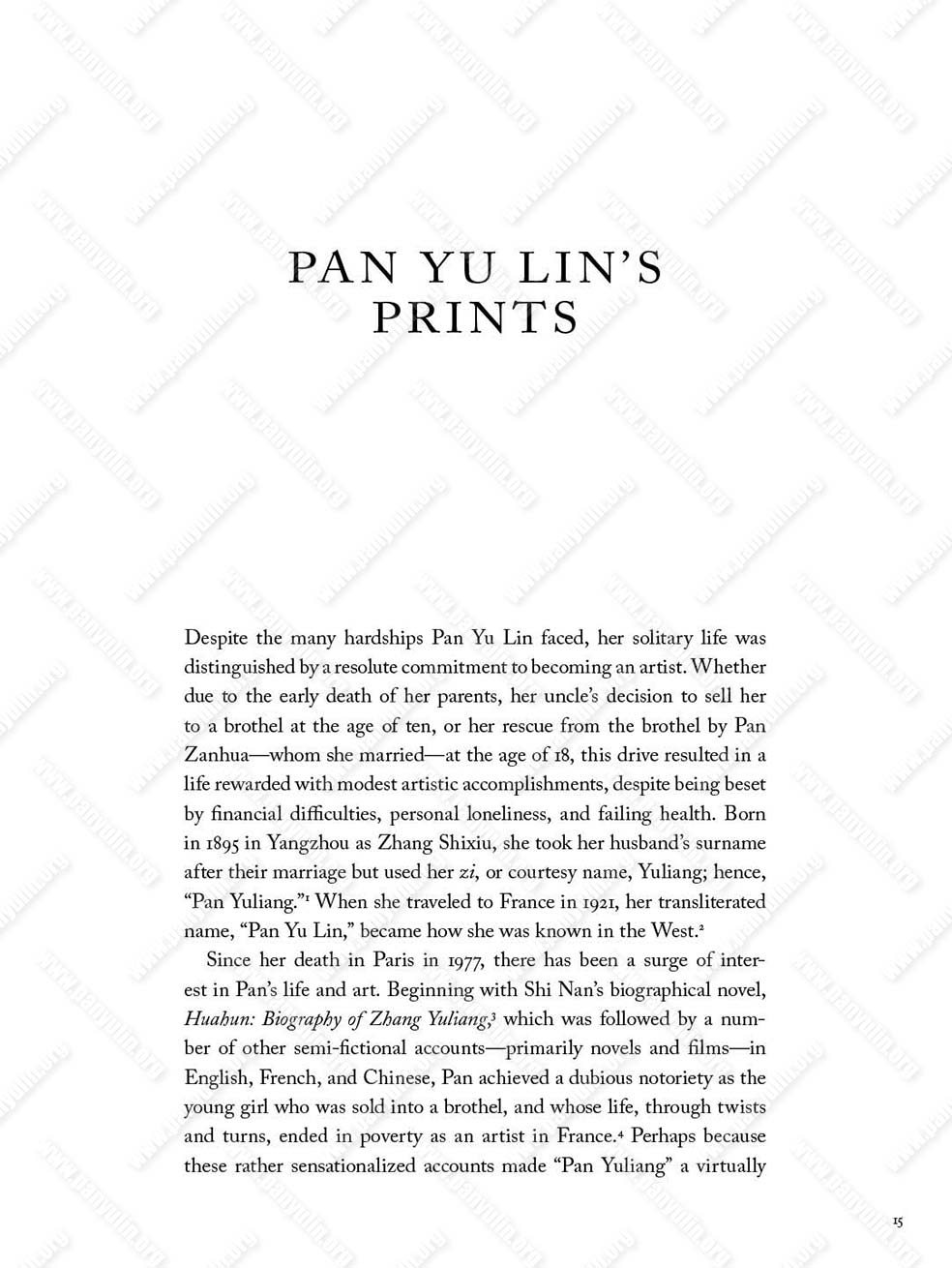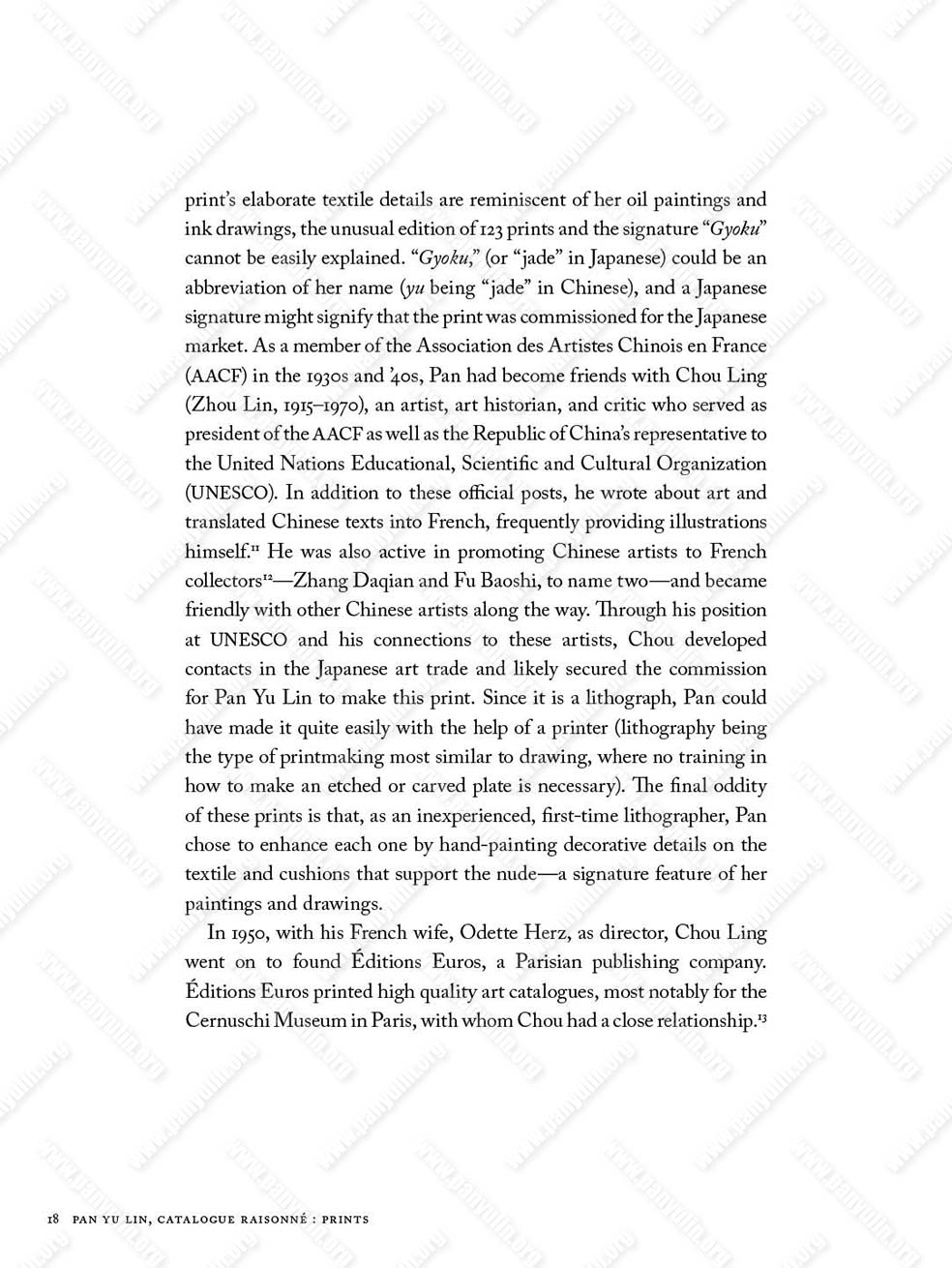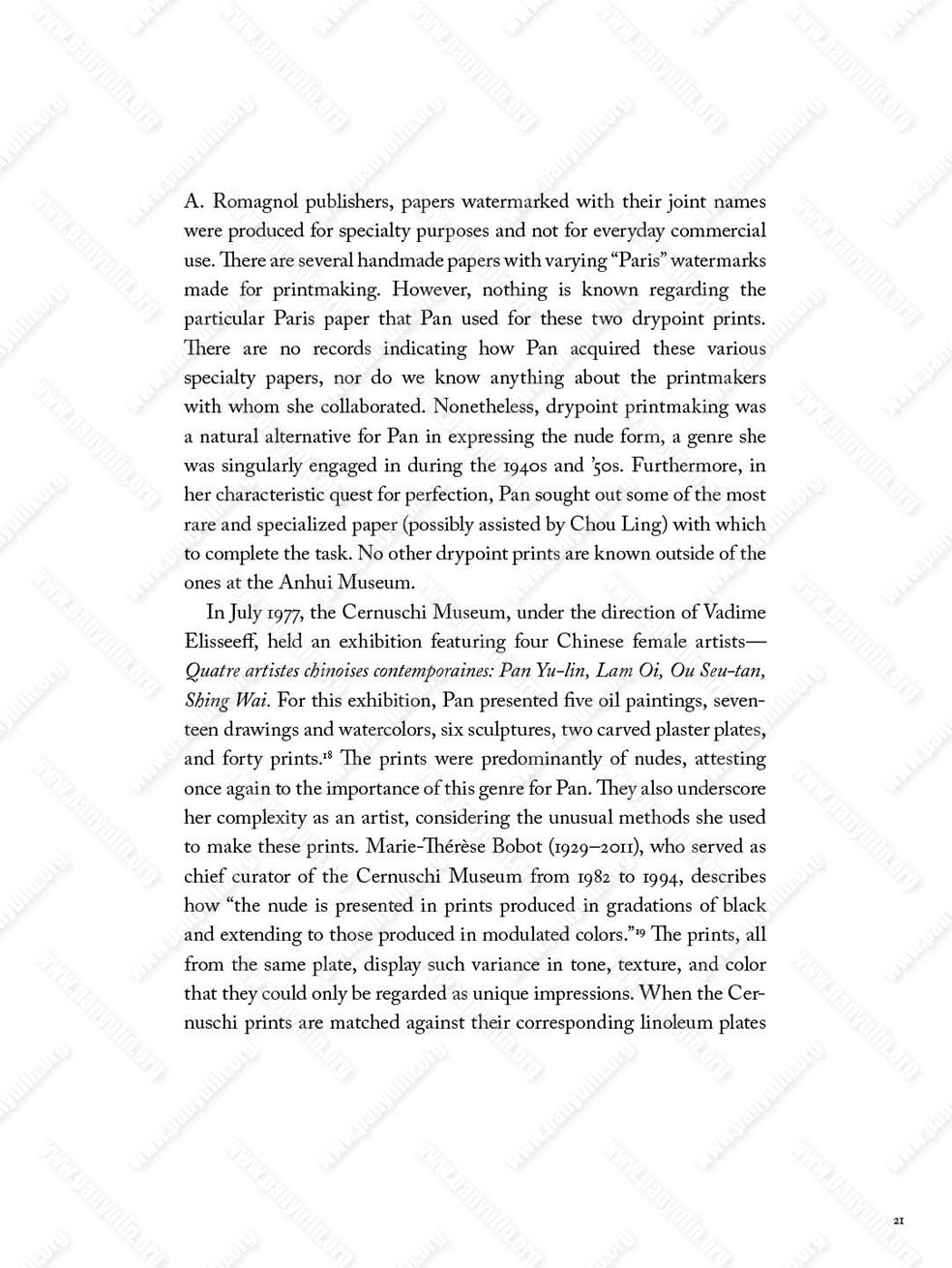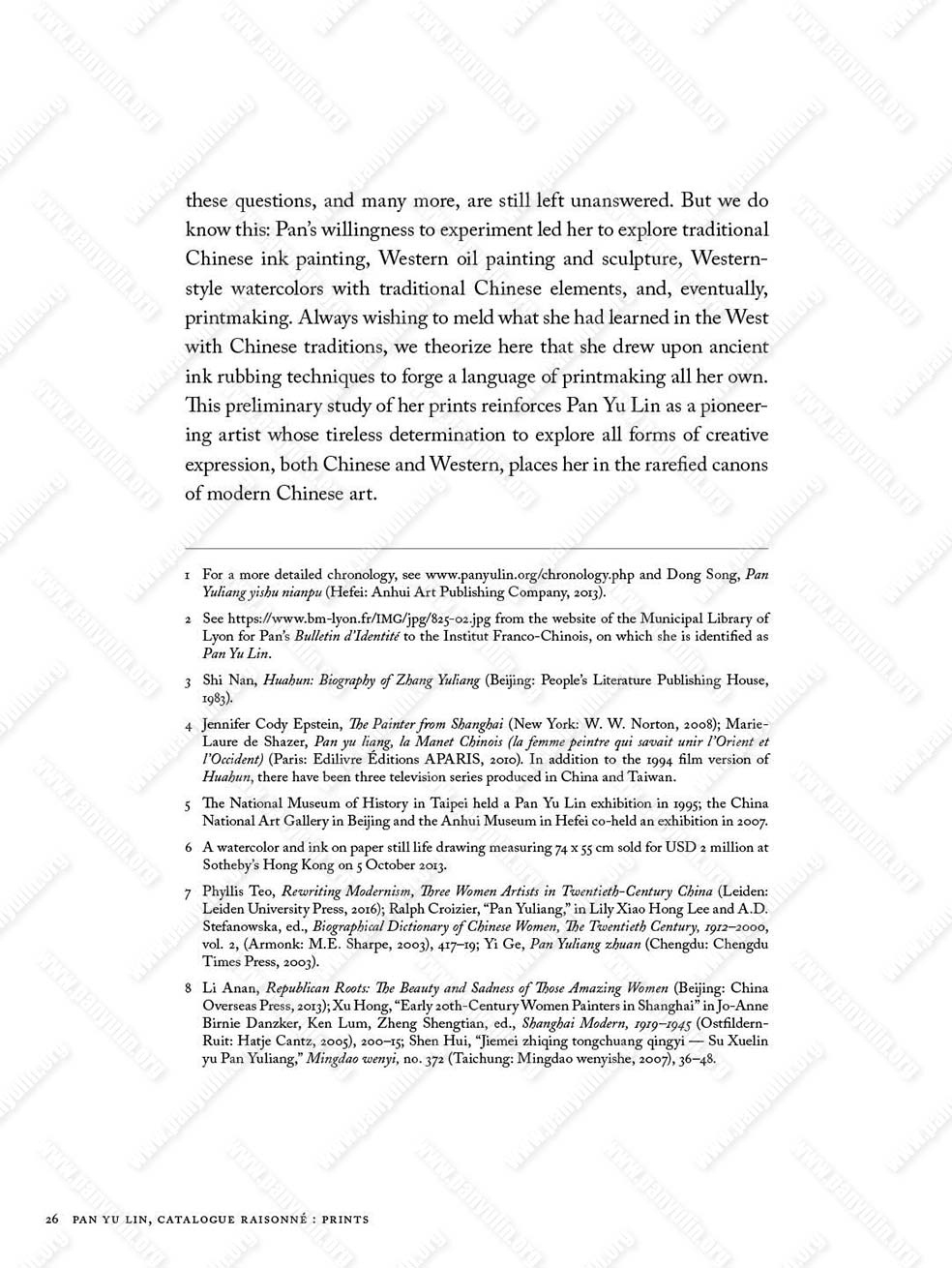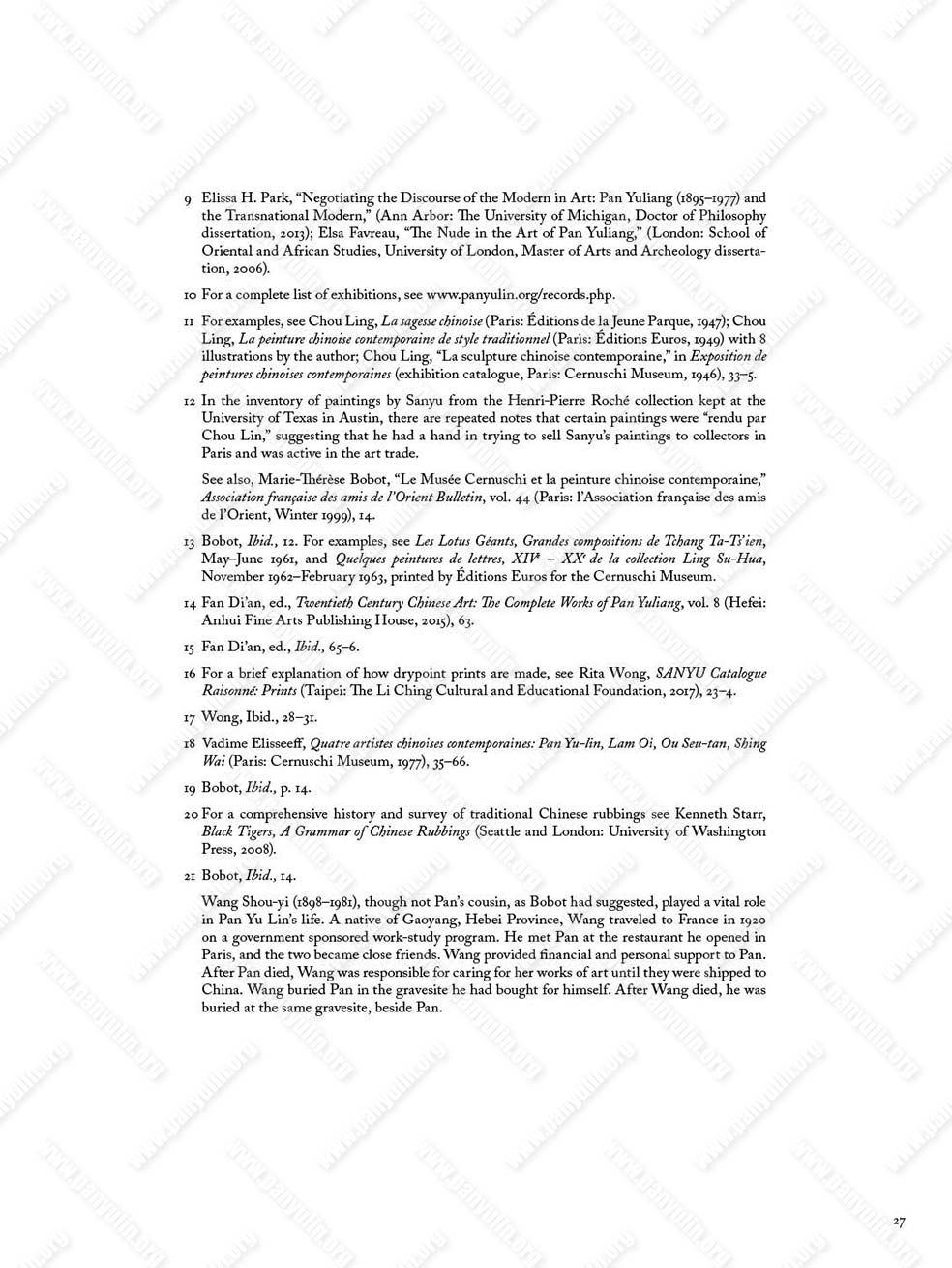Despite the many hardships Pan Yu Lin faced, her solitary life was distinguished by a resolute commitment to becoming an artist. Whether due to the early death of her parents, her uncle’s decision to sell her to a brothel at the age of ten, or her rescue from the brothel by Pan Zanhua—whom she married—at the age of 18, this drive resulted in a life rewarded with modest artistic accomplishments, despite being beset by financial difficulties, personal loneliness, and failing health. Born in 1895 in Yangzhou as Zhang Shixiu, she took her husband’s surname after their marriage but used her zi, or courtesy name, Yuliang; hence, “Pan Yuliang.”[1] When she traveled to France in 1921, her transliterated name, “Pan Yu Lin,” became how she was known in the West.[2]
Since her death in Paris in 1977, there has been a surge of interest in Pan’s life and art. Beginning with Shi Nan’s biographical novel, Huahun: Biography of Zhang Yuliang,[3] which was followed by a number of other semi-fictional accounts—primarily novels and films—in English, French, and Chinese, Pan achieved a dubious notoriety as the young girl who was sold into a brothel, and whose life, through twists and turns, ended in poverty as an artist in France.[4] Perhaps because these rather sensationalized accounts made “Pan Yuliang” a virtually household name in Asia, museums in China and Taiwan have launched large-scale retrospectives that have introduced her art to wide and curious audiences. [5] International auction houses have also taken the opportunity to offer her highly sought after paintings to a growing number of collectors at prices that have rapidly escalated over the past decade.[6] In addition to exhibition catalogues and monographs introducing Pan and her art, there have also been a number of studies that focus on how the revolutionary nature of her work, specifically her unique synthesis of Eastern and Western artistic traditions, elevated her to the rank of a major progenitor of modern Chinese art. [7] Other approaches focus on her role as a female artist in a predominantly male world and how she navigated that path with other Chinese women of the era, such as Fang Junbi and Su Xuelin. [8] Recently, there have also been a growing number of academic studies on the role of the nude in Pan Yu Lin’s art and the significance of this Western genre for the artist, particularly as it pertains to her vision of herself as a woman. [9]
Throughout her life, Pan demonstrated a dogged determination to excel as an artist. Only one year after gaining entry to the Shanghai Academy of Fine Arts in 1920, Pan was expelled by school authorities who needed to appease a student body that had learned of her life in a brothel. Fortunately for her, however, she was accepted into the Institut franco-chinois de Lyon that same year, and took classes at the École nationale supérieure des beaux-arts de Lyon from 1921–23 as well. During this time, she frequently travelled to Paris to study art with Lucien Simon, despite the conflicts it created with the two schools in Lyon. She was subsequently accepted into the École nationale supérieure des beaux-arts de Paris, where she remained for two years. In 1925, Pan went to Rome to study painting and sculpture at the Accademia di Belle Arti di Roma, receiving an annual stipend from the Italian Ministry of Education and a certificate from the Accademia after three years. These successes help demonstrate Pan’s tenacity and perseverance, as she was undeterred by the many financial and personal obstacles and difficulties that befell her.
Pan returned to China in 1928 upon the completion of her studies. For the next nine years, she taught at the Shanghai Academy of Fine Arts and later at the National Central University in Nanjing. She formed art associations with fellow artists and participated in no less than five individual and fourteen group exhibitions.[10] Even though she was active in China’s art communities and received acclaim for her pioneering work, she felt as though she had accomplished little since her return to China and decided to go back to Paris for two more years of European painting experience in 1937. However, the eruption of World War II and the onset of an unspecified nasal condition, which necessitated a total of five operations, prevented Pan from ever returning home to China.
During the war years, Paris was one of the main targets for the looting of priceless artwork and the plunder of Jewish-owned property by the Nazis. World War II was a difficult time for everyone in Europe, including artists—particularly foreign artists—and in 1940, Pan took refuge in the French countryside. During this period, many artists turned to printmaking to supplement their income by offering a less expensive alternative to collectors. In addition to economic incentives, printmaking provided artists with an opportunity to develop new techniques, thereby expanding their artistic lexicon. Pan was no exception, and tried to sell some of her prints at this time, although with limited success.
Pan’s earliest—and most unusual—print was a lithograph (P21) dated 1943. Even though the subject of a reclining nude with a cat and the print’s elaborate textile details are reminiscent of her oil paintings and ink drawings, the unusual edition of 123 prints and the signature “Gyoku” cannot be easily explained. “Gyoku,” (or “jade” in Japanese) could be an abbreviation of her name (yu being “jade” in Chinese), and a Japanese signature might signify that the print was commissioned for the Japanese market. As a member of the Association des Artistes Chinois en France (AACF) in the 1930s and ’40s, Pan had become friends with Chou Ling (Zhou Lin, 1915–1970), an artist, art historian, and critic who served as president of the AACF as well as the Republic of China’s representative to the United Nations Educational, Scientific and Cultural Organization (UNESCO). In addition to these official posts, he wrote about art and translated Chinese texts into French, frequently providing illustrations himself.[11] He was also active in promoting Chinese artists to French collectors [12]—Zhang Daqian and Fu Baoshi, to name two—and became friendly with other Chinese artists along the way. Through his position at UNESCO and his connections to these artists, Chou developed contacts in the Japanese art trade and likely secured the commission for Pan Yu Lin to make this print. Since it is a lithograph, Pan could have made it quite easily with the help of a printer (lithography being the type of printmaking most similar to drawing, where no training in how to make an etched or carved plate is necessary). The final oddity of these prints is that, as an inexperienced, first-time lithographer, Pan chose to enhance each one by hand-painting decorative details on the textile and cushions that support the nude—a signature feature of her paintings and drawings.
In 1950, with his French wife, Odette Herz, as director, Chou Ling went on to found Éditions Euros, a Parisian publishing company. Éditions Euros printed high quality art catalogues, most notably for the Cernuschi Museum in Paris, with whom Chou had a close relationship.[13] Two years later, he moved his offices to Quai d’Orsay. There, he opened Galerie d’Orsay and organized L’Exposition de Madame Pan Yu Lin in 1953. The show exhibited 114 works, including an etching of a nude (P20) printed by Éditions Euros in a limited edition of thirty-five, with a cover album designed by Chou Ling himself. The plate for this print (PP20), in the collection of the Anhui Museum in Hefei, is a wood panel mounted with zinc on which etched lines cast the shape of a nude. This type of print plate—one taken from a drawing or sketch by the artist—is usually made by a professional plate maker. In addition to the limited edition print, this plate was also used for the exhibition poster.[14] In 1957, Chou organized a second exhibition for Pan at Galerie d’Orsay, also sponsored by Éditions Euros.[15] It is worth noting that, in addition to her other works, prints were displayed at both exhibitions, and were featured as the main attraction in the case of the 1953 exhibition. Through commissions from museums and galleries, as well as his own illustrated publications, Chou undoubtedly learned a great deal about prints and printmaking during his tenure as owner of Éditions Euros. It is fair to speculate that he, in turn, taught Pan printmaking techniques.
In the Anhui Museum collection, there are a number of drypoint prints; [16] they are all of nudes, and only one (P6) is dated (1950). Even though the other drypoints are not dated, it is logical to surmise that Pan made most of her drypoints during the 1940s and ’50s considering their stylistic similarities and her choice of paper type (discussed below). As stated in the Preface, there were only two Chinese artists working in drypoint, a completely Western intaglio printmaking technique, during the first half of the twentieth century: Pan Yu Lin and Sanyu. Even though drypoints were common and popular among artists in Europe, the technique was unknown in China. Commissioned to make three etchings for Les Poèmes de T’ao Ts’ien in 1930, Sanyu learned about intaglio printmaking from the publishers and printers of the book.[17] Similarly, Pan Yu Lin most likely learned Western printmaking from Chou Ling and the master printmakers working with him in Paris. For these Chinese artists, with their skills in calligraphy and the curvilinear lines of traditional ink painting, intaglio printmaking quickly became a natural extension of their artistic output.
Perhaps the most distinguishing feature of Pan Yu Lin’s drypoint prints is the particular type of paper she chose. Even though the majority of her works were printed on Rives BFK, a well-known specialty paper for printmaking, she also chose lesser-known and unusual papers. There are five drypoints on Japon ancien, two on Perrigot-Masure, two on Académie des Goncourt A. Romagnol, and two on Paris paper. Japon ancien is a handmade paper from mulberry bark. It was originally from Japan, but became so popular among European printmakers in the twentieth century that paper makers in France also started to make it, selling it under the same name. Perrigot-Masure, a specialty paper made by Arches, is named after Albert Masure, one of the paper mill’s nineteenth century owners, and Jules Perrigot, his son-in-law who took over the mill’s operations in the early twentieth century. The Académie des Goncourt, still in existence today, is a literary society founded in the late nineteenth century to promote and encourage literature in France. In addition to awarding works of fiction, the Académie also published its Collection de l’Académie des Goncourt, featuring livre illustré, in which artists would produce woodblock prints to illustrate texts; A. Romagnol Éditeurs printed this collection in the early twentieth century. There are no readily available records of paper with the “Académie des Goncourt A. Romagnol ” watermark, aside from the two prints referenced here; it can be assumed, however, that, given the literary activities of the Académie and their long term collaboration with A. Romagnol publishers, papers watermarked with their joint names were produced for specialty purposes and not for everyday commercial use. There are several handmade papers with varying “Paris” watermarks made for printmaking. However, nothing is known regarding the particular Paris paper that Pan used for these two drypoint prints. There are no records indicating how Pan acquired these various specialty papers, nor do we know anything about the printmakers with whom she collaborated. Nonetheless, drypoint printmaking was a natural alternative for Pan in expressing the nude form, a genre she was singularly engaged in during the 1940s and ’50s. Furthermore, in her characteristic quest for perfection, Pan sought out some of the most rare and specialized paper (possibly assisted by Chou Ling) with which to complete the task. No other drypoint prints are known outside of the ones at the Anhui Museum.
In July 1977, the Cernuschi Museum, under the direction of Vadime Elisseeff, held an exhibition featuring four Chinese female artists—Quatre artistes chinoises contemporaines: Pan Yu-lin, Lam Oi, Ou Seu-tan, Shing Wai. For this exhibition, Pan presented five oil paintings, seventeen drawings and watercolors, six sculptures, two carved plaster plates, and forty prints.[18] The prints were predominantly of nudes, attesting once again to the importance of this genre for Pan. They also underscore her complexity as an artist, considering the unusual methods she used to make these prints. Marie-Thérèse Bobot (1929–2011), who served as chief curator of the Cernuschi Museum from 1982 to 1994, describes how “the nude is presented in prints produced in gradations of black and extending to those produced in modulated colors.” [19] The prints, all from the same plate, display such variance in tone, texture, and color that they could only be regarded as unique impressions. When the Cernuschi prints are matched against their corresponding linoleum plates at the Anhui Museum, however, an even more puzzling matter surfaces: normally, when prints are pulled from a carved plate, the plate itself is inked, and then, either manually or mechanically, pressed onto the receiving paper; the resulting print shows the mirror image of what appears on the plate. Upon examining the linoleum plates at the Anhui Museum that matched the prints at the Cernuschi, however, it was fascinating to discover that the plates and their corresponding prints had the same image orientation.
A possible explanation may be found in a printmaking technique whereby a freshly inked print (pulled from a plate) is immediately pressed onto another receiving surface, usually paper. In this scenario, the first print serves as a “cognate.” In other words, while the ink is still wet on the first print, it is pressed onto a second piece of paper, creating a mirror image of a mirror image so that what appears on the final print is identical to what appears on the plate. This process is typically used because special textural effects that are difficult to carve on a hard plate can be easily achieved on a paper cognate before being transferred onto the final print. While this explanation is satisfactory in determining how to technically achieve the same image orientation on the final print as that on the plate, it does not convincingly explain why an artist would go to such lengths just to create modulations in color, an effect not difficult to achieve with linocut printmaking techniques.
Pan Yu Lin’s predilection for referencing traditional Chinese art in her work, both in terms of technique and subject matter, provides a possible explanation for her unique impressions—specifically, the tradition of Chinese ink rubbings. Stone, metal, and pottery tile ink rubbings—whether of pictorial images or inscriptions—have been made in China for over two thousand years as a way to preserve history through precise reproductions. Frequently, all that remains of precious relics are these rubbings. The importance of ink rubbings in Chinese history cannot be underestimated, as the practice has been critical to preserving historical and art-historical information.[20] Although we do not know for certain, there is every reason to believe that Pan, being aware of this tradition, borrowed its technique to create the unique impressions in the Cernuschi collection.
In traditional rubbings, the paper used was usually thin, yet strong enough to withstand the stress caused by the continuous dabbing of ink on its surface. Papers needed to be pliable not only to adhere to the carved surface but also to allow for better absorption of ink. The paper used for ink rubbings of historical stone steles had to be thoroughly wet to ensure that it would firmly adhere to the stele; most of the time, steles would remain upright in situ and were often too large to be moved to a flat surface. With the wet paper molded against the stele or carving, these rubbings would usually have the equivalent of a plate mark once the paper dried. Once the paper had been properly affixed to the carved surface, ink would be applied with a tabao (or “dabber”) of varying size and shape depending on the nature of the carved matrix and the artist’s preference. The most common tabao shape was that of an inverted mushroom, the cap receiving the ink and the stem serving as handle. Dabbers were usually made by wrapping silk or cotton around a wad of wool, cotton, or another soft material that could hold ink. Once the dabber had absorbed the ink, it could be carefully blotted all over the paper, resulting in a black background contrasting against white, or uninked, carved lines and patterns. If the carving had been made in relief, the opposite effect would be achieved; that is, the raised areas delineating the design or characters would be highlighted by the black ink, contrasting against a white, uninked background. Whichever the resulting effects, ink rubbing is the opposite of printing in that the paper, not the plate or matrix, is inked. An ink rubbing produces a replica of its host, while a print produces a mirror image.
Borrowing the concept of ink rubbings, Pan used burlap-backed linoleum, which was easy to carve and readily available in France. The traditional Chinese paper that Pan used for all of her prints in the Cernuschi collection was soft, thin, and pliable enough to properly absorb ink and adhere to plates. She performed this process on a flat surface, and, due to the clarity and relative simplicity of her carvings, the paper did not need to be wetted and, therefore, did not end up with plate marks. With dabbers dipped in water-based inks of various colors, she achieved her desired effect, altering the colors of subjects and backgrounds as she wished. As is evident in her earlier lithographs and etchings printed by Éditions Euros, Pan was fond of hand coloring her prints. She did so to the Cernuschi prints as well, yielding unique impressions.
The forty prints in the Cernuschi Museum collection were presented in two albums. Each album had a cloth cover (see 160–63) that was most probably embroidered by Pan herself, one reading, “yijiu wuer nian diaoban huaji pan yuliang” (1952, collection of carved plate paintings, pan yuliang), and the other simply, “diaoban huaji” (collection of carved plate paintings). The Chinese term for a print, however, is banhua, which literally translates to “plate painting,” implying a work of art made from a plate. Normally, one would expect an album of prints to simply be titled “banhua ji” (Collection of Prints). Pan’s unusual choice of wording suggests that she might have regarded her works made from these linoleum plates not merely as prints, or multiples from a plate, but, rather, as paintings made from a carved plate. This suggests that each impression used the carved linoleum not as a printing plate but, instead, as a template for blotting or rubbing watercolors on paper. Interestingly, these works can simultaneously be seen as both and neither a print and/or a painting. Chou Ling described the limited edition print that Pan offered in her 1953 exhibition at Galerie d’Orsay as a peinture (painting), implying that, even though it was an etching, the hand-painted details qualified it as a painting. Despite this, the 1977 Cernuschi Museum exhibition, held just before Pan’s passing, described her works as gravures (prints), to which she, apparently, did not object. Rubbings are, after all, made from a matrix and are, therefore, a type of print.
Three months after the Cernuschi exhibition, Pan passed away. But as Marie-Thérèse Bobot recalls, it was “not without promising me the two linocut print albums. . . This donation took form as of 1978, thanks to the agreement of her cousin Wang Shou-yi, who was her legatee.”[21] No other unique impressions by Pan have been discovered outside of the Cernuschi collection. Similarly, no other drypoints are known aside from those in the Anhui collection. Curiously, even though there are multiple editions of the same print in Anhui, none of them are numbered. Only three of Pan’s prints are numbered: P20, an etching with an edition of thirty-five; P21, a lithography with an edition of 123; and P22, an etching with an edition of two hundred. We do not know which prints were sold at Galerie d’Orsay, but it appears that, without edition numbers, Pan had no intention of selling her drypoints or unique impressions specifically. Whether she regarded them as exercises in printmaking or another exploration in her arduous journey as a Chinese artist in Paris is not known.
How did Pan know about and obtain those rare, handmade papers for her drypoints? Why did she sign her name “Gyoku” on a lithography with an unusual edition of 123? How exactly did she make the unique impressions from linoleum plates she gave to the Cernuschi Museum? There is a sense of unease in going ahead with this publication when these questions, and many more, are still left unanswered. But we do know this: Pan’s willingness to experiment led her to explore traditional Chinese ink painting, Western oil painting and sculpture, Western-style watercolors with traditional Chinese elements, and, eventually, printmaking. Always wishing to meld what she had learned in the West with Chinese traditions, we theorize here that she drew upon ancient ink rubbing techniques to forge a language of printmaking all her own. This preliminary study of her prints reinforces Pan Yu Lin as a pioneering artist whose tireless determination to explore all forms of creative expression, both Chinese and Western, places her in the rarefied canons of modern Chinese art.
1. For a more detailed chronology, see www.panyulin.org/chronology.php and Dong Song, Pan Yuliang yishu nianpu (Hefei: Anhui Art Publishing Company, 2013).
2. See https://www.bm-lyon.fr/IMG/jpg/825-02.jpg from the website of the Municipal Library of Lyon for Pan’s Bulletin d’Identité to the Institut Franco-Chinois, on which she is identified as Pan Yu Lin.
3. Shi Nan, Huahun: Biography of Zhang Yuliang (Beijing: People’s Literature Publishing House, 1983).
4. Jennifer Cody Epstein, The Painter from Shanghai (New York: W. W. Norton, 2008); Marie-Laure de Shazer, Pan yu liang, la Manet Chinois (la femme peintre qui savait unir l’Orient et l’Occident) (Paris: Edilivre Éditions APARIS, 2010). In addition to the 1994 film version of Huahun, there have been three television series produced in China and Taiwan.
5. The National Museum of History in Taipei held a Pan Yu Lin exhibition in 1995; the China National Art Gallery in Beijing and the Anhui Museum in Hefei co-held an exhibition in 2007.
6. A watercolor and ink on paper still life drawing measuring 74 x 55 cm sold for USD 2 million at Sotheby’s Hong Kong on 5 October 2013.
7. Phyllis Teo, Rewriting Modernism, Three Women Artists in Twentieth-Century China (Leiden: Leiden University Press, 2016); Ralph Croizier, “Pan Yuliang,” in Lily Xiao Hong Lee and A.D. Stefanowska, ed., Biographical Dictionary of Chinese Women, The Twentieth Century, 1912–2000, vol. 2, (Armonk: M.E. Sharpe, 2003), 417–19; Yi Ge, Pan Yuliang zhuan (Chengdu: Chengdu Times Press, 2003).
8. Li Anan, Republican Roots: The Beauty and Sadness of Those Amazing Women (Beijing: China Overseas Press, 2013); Xu Hong, “Early 20th-Century Women Painters in Shanghai” in Jo-Anne Birnie Danzker, Ken Lum, Zheng Shengtian, ed., Shanghai Modern, 1919–1945 (Ostfildern-Ruit: Hatje Cantz, 2005), 200–15; Shen Hui, “Jiemei zhiqing tongchuang qingyi — Su Xuelin yu Pan Yuliang,” Mingdao wenyi, no. 372 (Taichung: Mingdao wenyishe, 2007), 36–48.
9. Elissa H. Park, “Negotiating the Discourse of the Modern in Art: Pan Yuliang (1895–1977) and the Transnational Modern,” (Ann Arbor: The University of Michigan, Doctor of Philosophy dissertation, 2013); Elsa Favreau, “The Nude in the Art of Pan Yuliang,” (London: School of Oriental and African Studies, University of London, Master of Arts and Archeology dissertation, 2006).
10. For a complete list of exhibitions, see www.panyulin.org/records.php.
11. For examples, see Chou Ling, La sagesse chinoise (Paris: Éditions de la Jeune Parque, 1947); Chou Ling, La peinture chinoise contemporaine de style traditionnel (Paris: Éditions Euros, 1949) with 8 illustrations by the author; Chou Ling, “La sculpture chinoise contemporaine,” in Exposition de peintures chinoises contemporaines (exhibition catalogue, Paris: Cernuschi Museum, 1946), 33–5.
12. In the inventory of paintings by Sanyu from the Henri-Pierre Roché collection kept at the University of Texas in Austin, there are repeated notes that certain paintings were “rendu par Chou Lin,” suggesting that he had a hand in trying to sell Sanyu’s paintings to collectors in Paris and was active in the art trade.
See also, Marie-Thérèse Bobot, “Le Musée Cernuschi et la peinture chinoise contemporaine,” Association française des amis de l’Orient Bulletin, vol. 44 (Paris: l’Association française des amis de l’Orient, Winter 1999), 14.
13. Bobot, Ibid., 12. For examples, see Les Lotus Géants, Grandes compositions de Tchang Ta-Ts’ien, May–June 1961, and Quelques peintures de lettres, XIVe – XXe de la collection Ling Su-Hua, November 1962–February 1963, printed by Éditions Euros for the Cernuschi Museum.
14. Fan Di’an, ed., Twentieth Century Chinese Art: The Complete Works of Pan Yuliang, vol. 8 (Hefei: Anhui Fine Arts Publishing House, 2015), 63.
15. Fan Di’an, ed., Ibid., 65–6.
16. For a brief explanation of how drypoint prints are made, see Rita Wong, SANYU Catalogue Raisonné: Prints (Taipei: The Li Ching Cultural and Educational Foundation, 2017), 23–4.
17. Wong, Ibid., 28–31.
18. Vadime Elisseeff, Quatre artistes chinoises contemporaines: Pan Yu-lin, Lam Oi, Ou Seu-tan, Shing Wai (Paris: Cernuschi Museum, 1977), 35–66.
19. Bobot, Ibid., p. 14.
20. For a comprehensive history and survey of traditional Chinese rubbings see Kenneth Starr, Black Tigers, A Grammar of Chinese Rubbings (Seattle and London: University of Washington Press, 2008).
21. Bobot, Ibid., 14.
Wang Shou-yi (1898–1981), though not Pan’s cousin, as Bobot had suggested, played a vital role in Pan Yu Lin’s life. A native of Gaoyang, Hebei Province, Wang traveled to France in 1920 on a government sponsored work-study program. He met Pan at the restaurant he opened in Paris, and the two became close friends. Wang provided financial and personal support to Pan. After Pan died, Wang was responsible for caring for her works of art until they were shipped to China. Wang buried Pan in the gravesite he had bought for himself. After Wang died, he was buried at the same gravesite, beside Pan.

